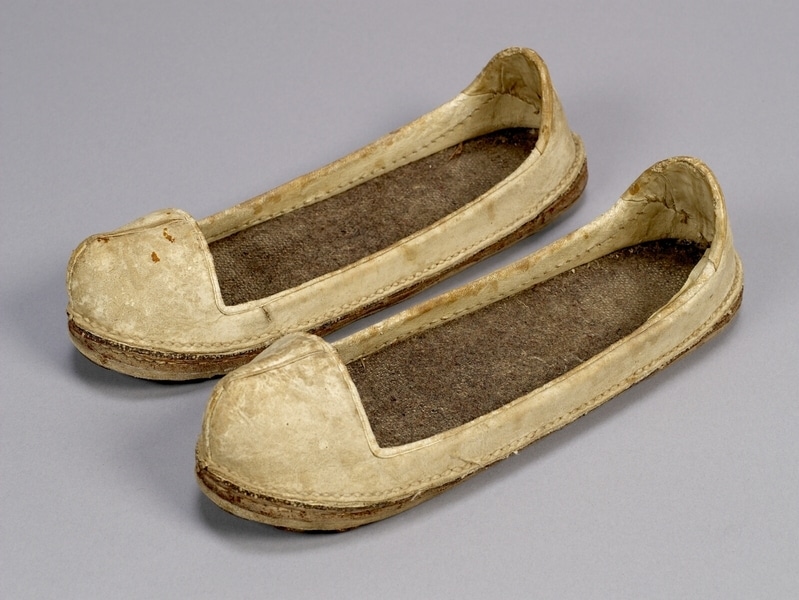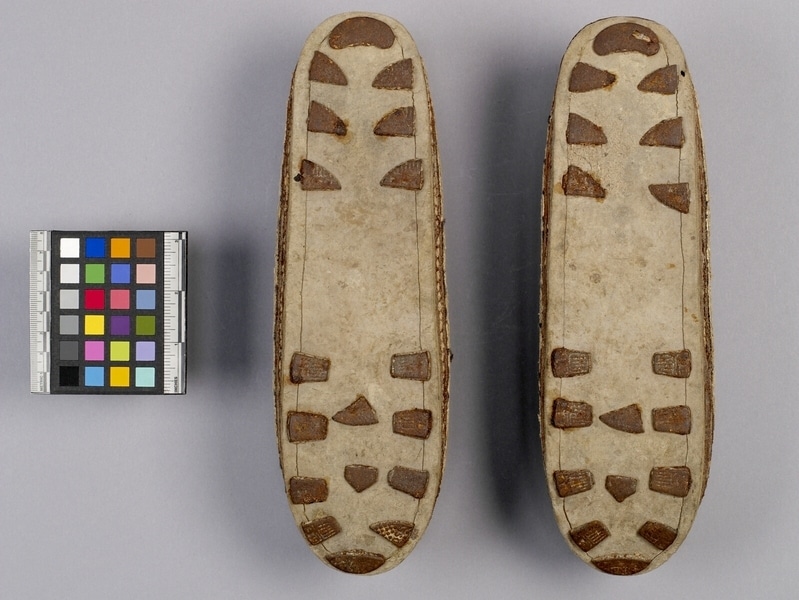Shoes Item Number: 984/12 a-b from the MOA: University of British Columbia



Description
Pair of man’s funeral shoes made of fine white leather. The sides are low, but there is an upward extension at the heel, which has a centre seam covered with five vertical cotton strings. Section covering toes is very short; the main body of each shoe is open. There is narrow piping finishing the vertical seam at the front of the toe section, and wider piping around the upper edge of the shoes. The soles are made of layers of natural brown leather slightly thicker at the toe and heel ends, and have numerous iron cleats at the front and heel. The soles are attached to the body of the shoes with a row of stitching around the edge of the soles, and there is a row of heavy, even stitches around the edge of the white leather. The shoes are lined with white leather, and have insoles of woven grey wool fabric.
History Of Use
Such shoes were worn by men of the official “Yangban” class in their daily life during the later years of the Chosun Dynasty. Those made of deerskin were very expensive. If they were attributed the special meaning :”white shoes”, they could be worn one to two years after the death of a parent, following the coarse shoes made of paper, coarse ramie, or hemp worn at the time of the funeral. Such shoes were worn outdoors, and not within the court. The iron cleats were to prevent the wearer from slipping. They were made by masters. Iconographic Meaning: The fact the sides are relatively high means that the shoes were made for men. The sides of women’s shoes were low, but the toe portion curved up higher than that on men’s shoes. Their shape indicates that the wearer was a member of the official “Yangban” class. White can be a sign of mourning.
Specific Techniques
The soles are made of numerous layers of leather stitched together with cotton thread.
Item History
- Made in Korea between 1800 and 1900
- Owned by Hi Soon Kim before August 7, 1984
- Received from Hi Soon Kim (Seller) and Unknown (Funding source) on August 7, 1984
What
- Name
- Shoes
- Identification Number
- 984/12 a-b
- Type of Item
- shoe
- Material
- cow skin ?, deer skin ?, dye, cotton fibre, wool fibre and iron metal
- Manufacturing Technique
- cut, tanned, dyed, formed, sewn, spun, woven and nailed
- Part A
- height 8.0 cm, width 8.4 cm, depth 27.8 cm
- Part B
- height 8.0 cm, width 8.3 cm, depth 27.7 cm
Who
- Culture
- Korean
- Previous Owner
- Hi Soon Kim
- Received from
- Hi Soon Kim (Seller) and Unknown (Funding source)
Where
- Holding Institution
- MOA: University of British Columbia
- Made in
- Korea
When
- Creation Date
- between 1800 and 1900
- Ownership Date
- before August 7, 1984
- Acquisition Date
- on August 7, 1984
Other
- Condition
- fair
- Accession Number
- 0984/0012 a-b